The Google Nexus 9 Review
by Joshua Ho & Ryan Smith on February 4, 2015 8:00 AM EST- Posted in
- Tablets
- HTC
- Project Denver
- Android
- Mobile
- NVIDIA
- Nexus 9
- Lollipop
- Android 5.0
Battery Life
It goes without saying that battery life is one of the most important aspects of a mobile device. After all, a mobile device isn’t really mobile if it can only be used for an hour before running out of battery. In order to test this, we turn to our standard suite of battery life tests, which include our web browser battery life test, along with some compute-bound benchmarks to characterize battery life across various use cases.
However, as the Nexus 9 introduces such a unique CPU architecture, I felt that it was necessary to try and adequately capture the full extent of battery life. To this end, I’ve introduced a new test that is really quite simple but important, as we can start to separate display power from everything else since it can often be the single largest consumer of power in a test. In order to do this, everything that could run during a test is disabled, and the device is placed in airplane mode with the display at 200 nits. A white image is displayed on the screen from a full charge until the device shuts down.
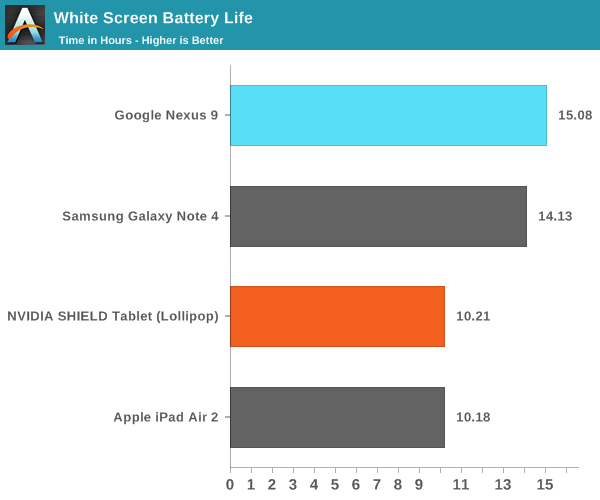
Interestingly enough, the display runtime on the Nexus 9 is about as good as it gets when compared to other devices for which we have data. I suspect we’re looking at the direct result of the large battery combined with an efficient display, as the Nexus 9 can last as long as 15 hours in this test compared to the iPad Air 2’s 10 hours.
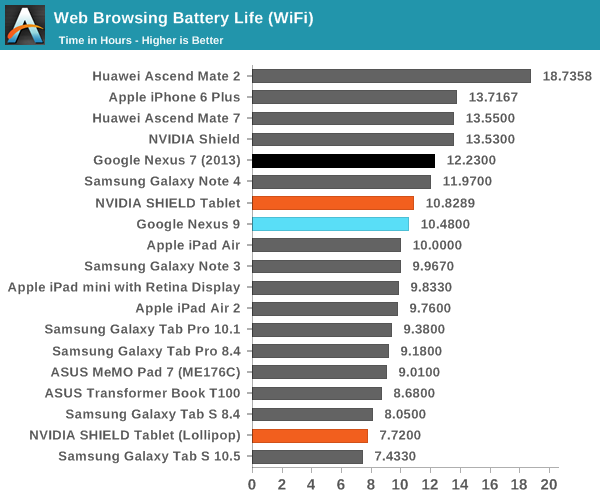
Unfortunately, the massive lead that we saw with the pure display test is significantly eroded in our web browser test. Our web test is primarily focused upon CPU, connectivity, and display efficiency. Seeing as how the Nexus 9’s display is far ahead of the iPad Air 2 and connectivity should be broadly similar in power efficiency, it seems that all of the efficiency gains from the display have gone into powering the Denver CPUs. It’s likely that process has a significant effect on this, so the more valid comparison is between SHIELD Tablet and the Nexus 9. At any rate, the Nexus 9 does manage to deliver solid battery life performance in this test which is definitely a good thing.
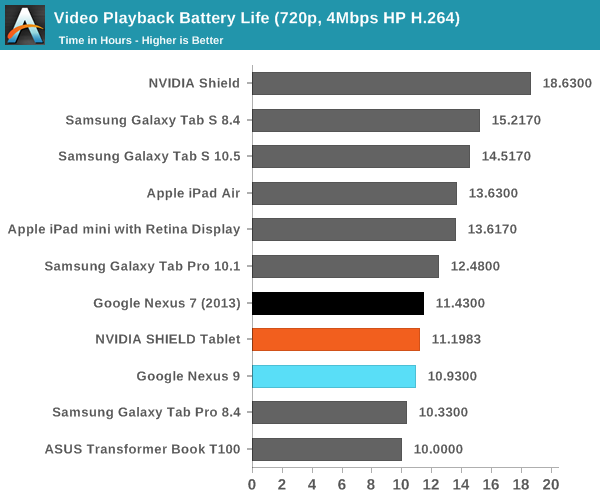
When we move to our pure video test, the Nexus 9 does have a minor regression when compared to the Nexus 7 (2013) and SHIELD Tablet. In this case, the AMOLED displays on the Galaxy Tab S line make for an easy victory due to the relatively high amount of black displayed in the content. The gap is closed between the two devices though, due to a reduced focus on SoC power.
While our web browsing test can give some idea of efficiency, there are often cases where more compute is directly used to support a better experience. To try and test for these compute-bound cases, we use Basemark OS II’s CPU battery life test and GFXBench’s T-Rex rundown for a GPU battery life test. As with the web browsing tests, these are run at 200 nits to keep things relatively equal.


In Basemark OS II, the Nexus 9 does a surprisingly good job as the CPU manages to keep incredibly high sustained performance. The large battery and efficient display seem to help to a significant extent.
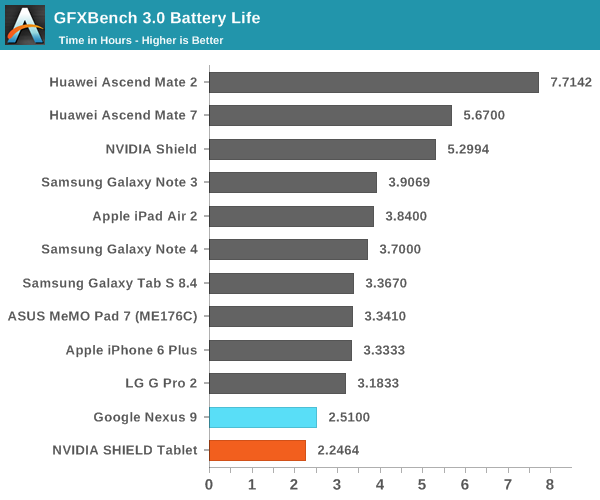
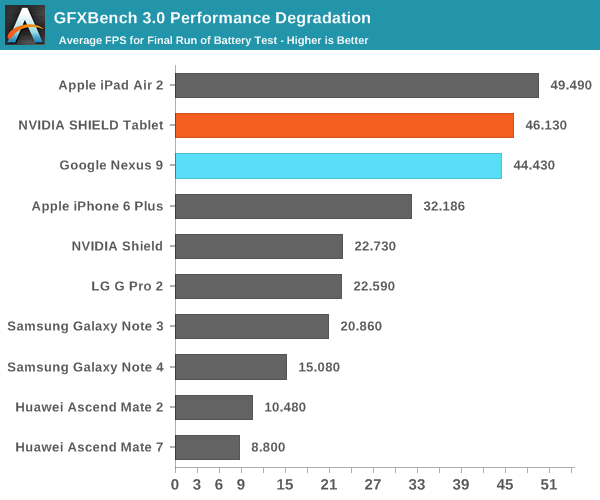
In GFXBench, it seems that not much changes overall. The GPU is definitely more power hungry than the PowerVR Series 6XT line-up and sustained performance is noticeably worse, but it’s in line with the SHIELD Tablet. End of run performance ends up a bit lower, but higher than one might expect. This is likely due to differing ambient temperatures. In practice, skin temperatures are about 45C in this test and localized to the top half of the device, and it’s likely that internal temperatures are around 80C as well. Seeing as how Tegra K1 can theoretically draw 33W in platforms such as the Jetson TK1 dev board with active cooling, it's incredibly impressive to see NVIDIA effectively keep such a powerful SoC within the constraints of a passively-cooled tablet.
Charge Time
While battery life is one part of the equation, charge time is an equally important aspect of overall battery life. To measure this, we measure the time from when charging begins to when the device reaches 100% charge. This is confirmed by taking measurements at the power outlet to make sure that power draw is below a certain level.
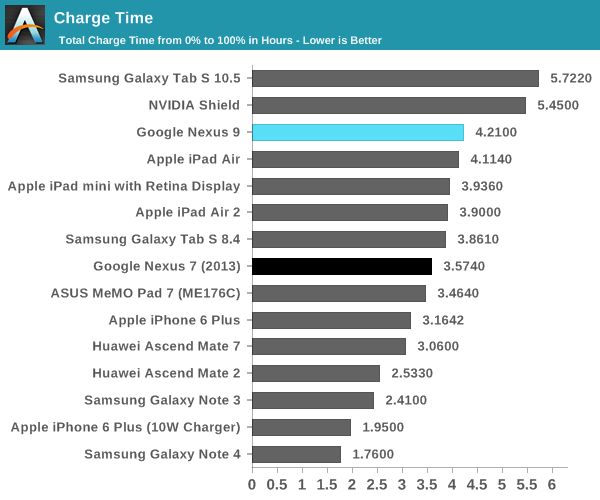
In this regard, the Nexus 9 is merely average for a tablet, although it does fall behind the competition as it uses a 5V, 1.5A charger for 7.5W instead of the 12-15W chargers that we’ve seen recently. It shouldn’t be a big issue, but in general this does mean that devices like the Galaxy Note 4 are actually better at battery life overall when compared to most tablets.










169 Comments
View All Comments
lucam - Thursday, February 5, 2015 - link
Next time you will write the article for Anand.tuxRoller - Thursday, February 5, 2015 - link
Just tested on my N7 2013. Results were far higher than shown in the chart.SR:64.2->76.1
SW:18.4->30.1
RR:11.2->13.4
RW:0.7->3.1
mpokwsths - Thursday, February 5, 2015 - link
Well, your results are far far more improved than 10% Andrei says.3 devices by 2 different users, all showed vast improvements (10-500%).
Only they refuse to acknowledge it.
Who knows, it seems Anandtech guys are on Apple's payroll...
eiriklf - Thursday, February 5, 2015 - link
Just wanted to note that on the NAND performance front, I believe the android devices which beat the nexus 9 in sequential speed use emmc 5.0 while the nexus uses a high quality emmc 4.5. I think this is because the tegra K1 SoC does not support emmc 5.0.tviceman - Wednesday, February 4, 2015 - link
Better late than never, although being this late is indeed a big letdown.Onto the hardware, looks like Denver is an interesting first custom SoC from Nvidia. Solid in some respects, lacking in others. I think it's a solid building block from which to work on and improve. I hope Nvidia continues the custom ARM core path and gets more design wins (if warranted) moving forward.
kepstin - Wednesday, February 4, 2015 - link
The Denver chip design is pretty interesting, but it reminds me very strongly of another mobile-targeted chip that didn't do well in the marketplace; the Transmeta Crusoe.Both are VLIW designs with in-order execution, both rely on software code translation that runs on the CPU itself. Both even used a partitioned section of system ram as a translated ops cache.
The most significant difference that I see between them is the addition of a native ARM decoder to the Denver CPU; the Crusoe didn't have a native X86 decoder and relied on the dynamic translation for all code that it executed.
I had a Crusoe for a while in a Sony Vaio; it was used in some of the very small/lightweight ultraportable laptops by Japanese manufacturers for a while.
phoenix_rizzen - Wednesday, February 4, 2015 - link
Didn't a large group of Transmeta devs get hired by Nvidia?ABR - Thursday, February 5, 2015 - link
Crusoe lost because Transmeta woke the sleeping giant Intel to the value of low-power, and then a group of 100 people couldn't keep up the resulting engineering race. The x86 world would be a pretty different place today if that hadn't occurred. But I'd say the jury is still out on the overall capability of the VLIW + morphing approach.frenchy_2001 - Thursday, February 5, 2015 - link
I would second that. A quick search returned a licensing agreement where nvidia licensed Transmeta's technology.This could be a good part of Denver.
About in order execution, the biggest experiment was from intel: itanium.
kgh00007 - Wednesday, February 4, 2015 - link
It's 3 months late, the nexus 9 was released on the 3rd of November!!No excuses, but it's just too late to help people make an informed decision!! Just like dog years, one year for a tablet is like 7 technology(dog) years!!